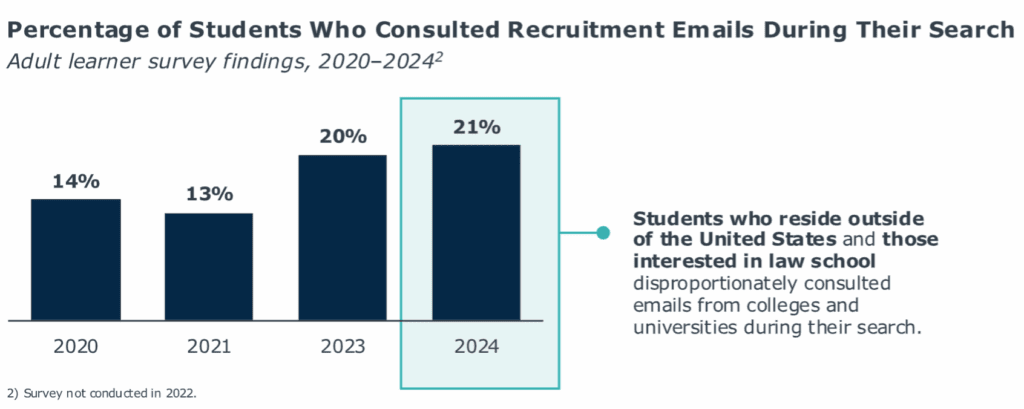Is your email marketing strategy outdated? Here’s what to do instead.
A few weeks ago, I met with a business school’s dean and head of marketing who were excited to share their new lead nurturing campaign for their MBA program. Like many higher ed campaigns, theirs used the new instance of Slate CRM and included pre-scheduled emails sent to every lead at the same time, regardless of who they are or how they engage. For example, every lead would receive a welcome message on Day 1, a curriculum overview on Day 3, and a deadline reminder on Day 10 (in industry parlance, these are called “drip campaigns”).
Sound familiar? If your team still relies on this one-size-fits-all approach, it’s time to say goodbye to 2015-era drip campaigns and join the ranks of modern marketing.
In 2025, when we have access to AI-powered tools and real-time behavior data, and when students expect personalization at every turn, this strategy doesn’t cut it. And it’s critical to get your email strategy right. Our annual surveys of prospective graduate and adult students show that recruitment emails are increasingly influential in students’ application and enrollment decisions.

Here’s how your team can move beyond traditional email marketing to connect with students more effectively.
1. Personalize content by student intent, not just first name or program
As a former higher ed CMO, and now in my work guiding dozens of universities in their grad enrollment marketing efforts, I’ve long been beating the drum about the need to personalize recruitment emails. But for most higher ed marketing teams, it’s not feasible to write 50 versions of a recruitment email. The good news is that generative AI tools can now help teams rapidly create variations of copy and imagery to test what resonates best—without starting from scratch every time.
But AI alone won’t cut it. You also need access to information about each student to help truly personalize your email copy. For example, our partner institutions use data gathered from micro-surveys, student interactions with your website or ads, and insights from our consumer database to help personalize their campaigns.
Let’s say you’re trying to recruit a student to your master’s in aerospace engineering. This student had previously deferred her application because she was concerned about meeting program prerequisites. And you know from a micro-survey you deployed to the student that she is interested in the program to advance her career. Check out the examples below of what a traditional recruitment email might look like—and how that differs from the second email, hyper-personalized based on what we know about this prospect.
-
Before – without personalization
When you choose a graduate program at ABC University Online, you can expect:
- Instruction from world-class faculty and industry experts
- A rigorous curriculum that combines theoretical knowledge with practical application
- The same quality education and degree as our on-campus programs, delivered entirely online
-
After – with hyper-personalization
When you choose the master’s in aerospace engineering at ABC University Online, you can expect:
- Instruction from world-class faculty and industry experts in aerospace engineering
- A curriculum that includes aerospace engineering, defense strategy, and leadership development
- The same quality education and degree as our on-campus programs, delivered entirely online
-
Before – without personalization
We understand that pursuing a graduate degree can come with challenges, but at ABC Online, we are here to support you every step of the way. Our flexible programs are designed to fit into your busy life, allowing you to balance your studies with your personal and professional commitments. With our dedicated support services, including academic advising, career development, and technical assistance, you’ll have everything you need to succeed.
Take the next step in your educational journey and begin your application today. At ABC Online there’s no application fee, and our streamlined application process ensures a fast admissions decision. Apply now to join a community of learners who are dedicated to excellence and ready to make a difference.
-
After – with hyper-personalization
We noticed that you previously deferred your application to ABC Online, and we understand that meeting program prerequisites can be a hurdle. We provide the support and resources you need to fulfill these requirements. Our academic advisors are here to guide you through the prerequisites, ensuring you have a clear path to enrollment.
Revisit your application today to take the next step in your educational journey. Remember, at ABC Online there’s no application fee, and our streamlined application process ensures a fast admissions decision. Become a part of a community of learners who are dedicated to excellence and ready to make a difference.
2. Let behavior, not time, drive campaign cadence
No matter how strong your creative is, it won’t resonate with prospects unless it is delivered at the right moment in their journey to enrollment. In the marketing campaigns we develop with our Adult Learner Recruitment partners, the cadence at which students receive this customized content is determined based on what we know about that student.
Instead of sending every student Email 3 on Day 3, modern enrollment campaigns adjust the flow based on how each student engaged with your marketing. For example, how a student first entered your campaign—such as through a submission to a request for information (RFI) form or after clicking on a Google ad—should dictate what content that student receives and when. From there, the cadence at which a student receives marketing from your institution can be tailored based on the frequency and type of engagement with your recruitment efforts.
Remember, adult students often spend months, if not years, researching programs prior to application. Ensure your email marketing streams take this extended timeline into account. The nurture campaigns we develop with our university partners last 25 months given how long it can take for students to make enrollment decisions.
We Secret Shopped 10 Lead Nurturing Campaigns—Here’s What We Learned
3. Use real-time data to continuously improve your email performance
If you or your enrollment marketing partner are not consistently monitoring how your campaigns are performing, you’re flying blind. While traditional email marketing metrics like open and click rates are useful, AI can help monitor which subject lines, messages, and themes are driving applications. You can Identify how long it takes from first touch to enrollment, determine where students are disengaging, and more.
Traditional email campaigns are no longer enough. Students expect relevant, timely, personalized content, just like they get from every other brand they engage with online. At a time when converting interest to applications and enrollments has never been more important, you can’t afford to use an old school email marketing playbook.

More Blogs

Adult learners: who they are and what they want from college

4 questions domestic students will ask before applying to your graduate program
